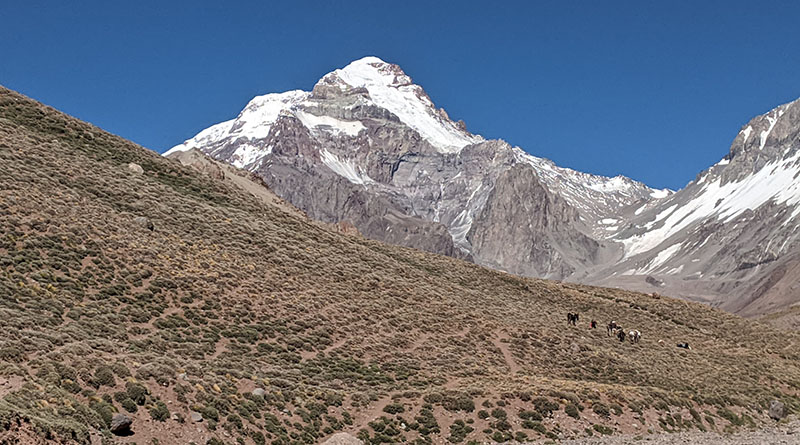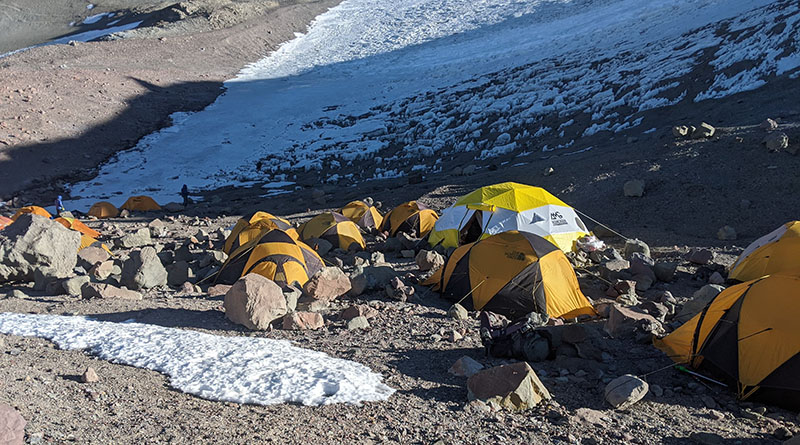Reaching for the sky
A local man stood near the top of the world last week, after ascending the world’s highest peak outside of the Himalayas.
With an altitude of 6,952 metres, Aconcagua in Mendoza, Argentina is known as one of the Seven Summits, which designates each of the highest peaks in every continent.
For Grand Calumet Island resident and physical and outdoor education teacher at l’École secondaire Sieur de Coulonge (ESSC), Martin Bertrand, the adventure to the top was the most daunting task he had ever undertaken.
“It was the hardest thing I’ve ever done in my life for sure,” he said. “It was a very unique and very awesome experience. It was definitely not a walk in the park.”
Consisting of a three-week expedition, Bertrand’s trip began on Dec. 14, when he took a connected flight from Toronto to Panama to Mendoza. Upon arriving in Argentina, Bertrand spent the next two days hiking to a couple of approach camps located in the Argentinian desert.
Trekking upwards of 16 km, under steaming hot weather in a particularly dry climate, Bertrand said he was absolutely exhausted
“It’s like walking on the moon or walking on Mars,” he said. “It was completely dry.”
While climbers carried loads of gear in the backpacks, a lot of it was brought to base camp by mules, Bertrand said.
After arriving at base camp (4,200 metres), the group had to climb to three high camps – at 5,000, 5,500 and 6,000 metres respectively - before making a 14-hour push towards to the summit on Dec. 30.
Following a strict itinerary, the group moved in six to seven-hour rotations en route to the top. While the weather was largely unfavourable during the first part of the climb, the schedule was set up so that climbers would have clear skies for their push to the summit.
“Once we got in position for the summit, we would actually have beautiful days,” he said. “I’d rather have the ugly days back at camp one and camp two and get the good days for the summit approach, which we were so lucky to have.”
Having undertaken a number of outdoor expeditions in different parts of the world in the past, including rafting in the Grand Canyon River in 2007, Bertrand noted that the trip was different that other trips he had taken.
He explained that while a corporation provided climbers with all the food they needed, participants still had to physically carry their supplies in backpacks from one camp to the next.
To acclimatize his body to the low oxygen levels, Bertrand said that climbers went through rotations in between camps with a routine of climbing high and sleeping low.
“I remember arriving to camp one and everybody was very dead,” he said. “You can’t just walk from base camp to the summit. You have to get your body acclimatized. When you’re high up like that, anything that you do takes your breath away,” he said.
“It’s extremely hard to breathe,” he said. “That’s why we do those rotations, so our bodies produce more red blood cells to carry more oxygen. Every step you take takes the wind out of you.”
In order to digest food quickly and keep a balanced blood pressure, Bertrand said that the diet on the mountain essentially consisted of sugar and carbohydrates. While the food didn’t come with a Michelin Star, he still remembers experiencing a few treats.
“It wasn’t the finest cuisine, but at the same time, when we were at camp two, on our rest day, we had probably one of the best mac and cheeses ever,” he said. “Camp three, which was the night before the summit attempt, we had mashed potatoes and hot dogs mixed together.”
For Bertrand one of the most challenging aspects about the climb was having to battle 70-80 km/h winds bearing down on tents and climbers doing everything they could to avoid falling to their deaths.
“Every time we were at camp one and camp two - camp one was the craziest – we had winds hitting us at around 80 k/h,” he said. “You’re trying to sleep in your tent and it’s vibrating like crazy. You’re trying to make it to the kitchen tent and they’re trying to collapse on you.”
“That was a huge challenge because you’re trying to go up and sometimes the winds were so strong that you had to literally brace yourself not to fall off the mountain or to get pushed off a very steep hill,” he added. “You had to fight the winds to keep going forward.”
Another challenge was the weight of the backpack, Bertrand said, which was roughly around 20-25 kg., about 50 lbs.
Bertrand said he was initially inspired to take the adventure when he was in university, around 20 years ago, upon hearing friends discussing their aspirations to take on a number of extreme outdoor expeditions.
“It just got me thinking ‘The highest mountain outside of Asia or the highest mountain in the Americas, just shy of 7,000 metres - there are the seven summits, which is not something I want to do - but at the same time, this is the biggest of the seven summits other than Everest,’” he said.
This time, he was invited by a group of outdoor enthusiasts from Toronto whom he met while rafting a few summers ago.
“They said they were going to Kilimanjaro, two of them had done Elbrus, which is the highest point in Europe,” he said. “They were on a quest of going around the world and doing some of the highest peaks – the seven summits. I said ‘If you guys ever want to do Aconcagua, I would be interested in that.’”
While he feels fortunate to have taken on the challenge and proud to have completed it, Bertrand admitted that the adventure was a lot more arduous than he had envisioned.
“I feel blessed but at the same time I feel like it’s a slap in the face,” he said. “I was definitely not as much in shape as I should’ve been for this trip. But at the same time, we were blessed to have an amazing crew and we had at the same time great weather cooperating with us for this trip.”
Joined by a strong team, which included the three Torontonians, a trio of Americans, two Australians and a female climber from the Netherlands, Bertrand said one of the best parts about the event was meeting and getting to know all sorts of interesting people with different backgrounds and interests.
“The guys from the US work for the army, one of them is a pilot, one of them is an engineer,” he said. “One of them was a programing engineer. The people from Australia were from the financial industry. It was a unique blend of people with different backgrounds, different ideas. It actually made it a pretty cool trip.”
Plus, with everyone feeling the same pain throughout the trek, he said it was amazing to see everyone assisting one another in times of need - whether it was sharing food or giving someone a hand with pushing their way up the cliff.
“Nobody knew each other that much, except for us Canadians,” he said. “It was pretty cool because it gave us a chance to see everybody in their moments of struggle and everybody at the same time helping each other out.”
Admittedly out of his comfort zone for the majority of the expedition, Bertrand said his main motivation behind taking on a feat like this one, was the desire to push himself to his limits and continuously challenge himself.
“Every time I do a mountain like this, it always sounds good once you start planning it and, once you’re there, you always think ‘What the hell am I doing here? Why am I suffering this much?’” he said. “It’s kind of funny. But it keeps me alive, it keeps me focused on different challenges because if you don’t challenge yourself, you’re never going to do anything.”
“Personally, I do these things for me,” he added. “It’s totally for me. I do it just hoping that I can still do it. Some people were joking that maybe it’s my mid-life crisis trip. But no, actually it’s one that I’ve been wanting to do for a long time.”
As a teacher, a father and a member of a small community, Bertrand hopes his long-envisioned accomplishment will drive others, whether it’s his students or other locals to set goals and chase their dreams no matter how big or far away they seem.
“I hope I inspire some of my students,” he said. “I hope I inspire people around the Pontiac that no matter the dream, no matter if it’s right now, no matter if it’s later, dream of something big and make that dream happen.”
“Aconcagua was a dream that I thought would never happen,” he added. “But luckily, I made it happen.”
Now back in the Pontiac after three weeks in the Southern Hemisphere, Bertrand said he looks forward to enjoying time with his family and relaxing, before getting settled back into his job at ESSC.
“I’m planning on bringing back the ski department we did last year with ESSC but also PHS and other communities,” he said. “That’s going to be my immediate focus.”
As far as future plans, Bertrand said he’s really interested in organizing a Pontiac trip to Kilimanjaro. While it’s one of the Seven Summits, he said that the mountain provides the sort of challenge that a lot of people can feasibly take on and still explore a special part of the world.
“I think it’s a nice entry level mountain trip but at the same time it’s exotic, it’s Africa,” he said. “I’m kind of hoping I’ll find energy and find a way to really convince people to jump on this crazy adventure. I don’t want to do it alone. I don’t want to do it with people I don’t know. I want to bring Pontiac people to Kilimanjaro.”
J.D. POTIÉ
Mendoza, Argentina Dec. 30, 2019


FREE ACCESS FOR EQUITY SUBSCRIBERS
This article is available free to all subscribers to The Equity. If you are a subscriber, please enter your email address and password below.
SET UP YOUR ONLINE ACCOUNT
If you are a subscriber but have not yet set up your online account, please contact Liz Draper at liz@theequity.ca to do so.
HOW TO BECOME A SUBSCRIBER
To become a subscriber to The Equity, please use our Subscribe page or contact liz@theequity.ca


